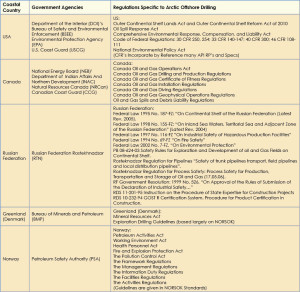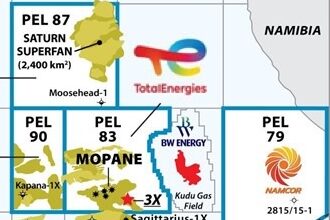Arctic regulations overview: flexibility, cooperation needed
International collaboration required for consistency; hybrid prescriptive, goal-based approach may ensure safety goals are met
By G.A. Ghoneim, Atkins Oil & Gas

The existence of comprehensive Arctic-specific regulatory regime is paramount for ensuring the safety of Arctic drilling and to lead to the successful development of vast Arctic resources. That’s estimated at more than 25% of world reserves, or approximately 90 billion barrels of oil and 1,669 trillion cu ft of natural gas. The US Geological Survey in 2010 estimated that an undiscovered 412 billion barrels of oil equivalent is present in the Arctic. Figure 1 outlines the geographical area of the Arctic.
It should be noted that Arctic drilling has been successfully undertaken by several Arctic coastal states, such as Canada and Russia. Arctic drilling has been carried out by companies, such as Dome Petroleum subsidiary Canadian Marine Drilling, Esso Resources Canada and Gulf Canada, since at least the early ’70s. Currently, Russia is leading in Arctic drilling and production. The country has comprehensive regulations in place and has been cooperating very effectively with Norway in this regard, through venues such as the Barents 2020 project.
This article will present the current status of the regulatory schemes of the five Arctic coastal states: US, Canada, Russia, Greenland (Denmark) and Norway. Much of what’s discussed here was referenced during the regulatory panel discussion at the Arctic Technology Conference held in Houston in December last year focusing on Arctic drilling. A Pembina Institute study published in June 2011, conducted for Canada’s National Energy Board (NEB), is an excellent source of identifying the necessary regulatory elements that must be addressed.
Regulatory approaches
The regulatory regimes include the laws used to govern offshore drilling activities and the regulations that provide details on how to comply with laws. The regulatory regime applies to environmental protection, safety, employment standards and worker safety, health protection, emergency planning, oil spill response and liability for accidents. Two basic approaches are the prescriptive and the goal-based, where the former specifies the methodology for achieving the goals of the regulator and the latter identifies the goals that must be achieved while allowing the operator the flexibility to choose the methodology that fits his proposed technology.
The five Arctic nations use one or the other or a hybrid (Table 1). Policies and other processes may affect the regime and become part of the regulatory approach to offshore drilling and production. For example:
• The resources, capacity, and expertise available to the regulator;
• Environmental, social, and/or economic assessments that the regulator carries out before issuing permits for exploration and production;
• The different agencies within the government that have the authority to grant legal rights to explore and develop oil and gas resources, collect royalties, and regulate HSE-related issues;
• The agencies that must coordinate their work to administer and enforce the offshore drilling regulatory regime; and
• The guidelines and best practices that may be included in the regulatory regime. For example, CFRs in the US rely mostly on API recommended practices and specs while Norway and Greenland refer to NORSOK standards.
It should be noted that when the regulatory scheme involves several government agencies, the coordination and definition of clear lines of responsibility is established through memoranda of agreement between the different agencies.

Regulations and guidelines
Table 2 lists all the regulations and guidelines that may be applied in each Arctic nation. The regulations specify the process that the operator must follow and the corresponding agencies that will be involved.
In a US Senate hearing in June this year, the Department of the Interior stated the Bureau of Ocean Energy Management is working to deliver Arctic-specific regulations by the end of 2013. The Bureau of Safety and Environmental Enforcement (BSEE) also indicated in July that it will do the same. It is therefore expected that the Arctic regulations picture will be significantly enhanced by the end of this year. The industry will surely be involved in order to ensure the regulations are practical and feasible and to help avoid future conflicts and misunderstandings.
On 30 July, an official with the NEB indicated that regulatory mechanisms are in place to ensure any future drilling in Arctic waters is done with the environment in mind and that no work would be permitted unless regulators are satisfied with the safety mechanisms. The NEB Arctic review concluded that tools are in place to protect the Arctic environment.
Forward looking
The most significant challenge in the Arctic is to address climate change and protect the environment. Using past experience in current efforts would be beneficial in designing new concepts for the Arctic.
In the US Arctic offshore Alaska and in the Beaufort Sea, Shell has already prepared a comprehensive plan for its Arctic development activities, and BSEE was in the process of reviewing those plans before Shell had to postpone its activities to 2014 or beyond. ConocoPhillips has announced that it will not drill in the Arctic in 2014, and Statoil is waiting in the wings to announce their plans.
The following offers pointers for Arctic regulation development:
• The development of Arctic-specific regulations is not an easy task, especially when new and unproven technology may be used in a pristine environment with zero tolerance. Therefore, the more flexible performance/goal-based approach becomes a necessity. The operator normally has more resources and understanding of the technology than the regulator. Hence, a need exists for independent verification that the set goals are met. For zero tolerance, an audit system would be required to verify the verifier.
Instead of a full performance-based approach, a combination is recommended that uses prescriptive guidelines on the higher levels; for example, defining the minimum design and acceptance criteria and, thus, the minimum safety level that must be met.
• It is necessary to require CRA, HAZID/HAZOP, QRA and other risk assessment studies for all drilling system components in the specific Arctic site environment. This involves experts identifying potential risks and associated solutions thereof within the set criteria. It is important to ensure 100% preparedness and a “no surprise” policy. Atkins is currently assisting operators with such studies.
• International cooperation is very important in order to achieve consistency. A disaster anywhere in the Arctic will affect all Arctic nations. There has been examples of such cooperation recently, such as that between the US (BSEE) and Canada (NEB) with an MOU signed on 4 February 2013 and between Russia and Norway.
The Arctic Council, formed in the mid-1990s and including the five coastal states plus Sweden, Finland and Iceland, has also been a success. Several non-Arctic countries, such as China and Japan, have applied for observer status. However, the group is still not anywhere near producing an international Arctic regulatory regime.
• Operator cooperation is also essential. All oil companies and drilling contractors looking to work in the Arctic must collaborate and share knowledge and experience in order to develop the Arctic. The exceptional cooperation that was demonstrated during Macondo should be possible to address the Arctic challenges that face all stakeholders.
• The development of the Arctic will require striking a balance between the benefits and risks using the ALARP principle, with enhancement to reach zero tolerance. This is feasible with creative thinking. The idea of using subsea systems with robotic technology has been suggested.
• The prescriptive standards dealing with Arctic structures are ISO 19906:2010, CSA-471-04:2004 and API 2N:1995. The draft of API 2N 3rd edition, based on ISO 19906, is under review for approval and publication. A need exists as noted above to harmonize all Arctic standards and reach consensus on unified requirements.




